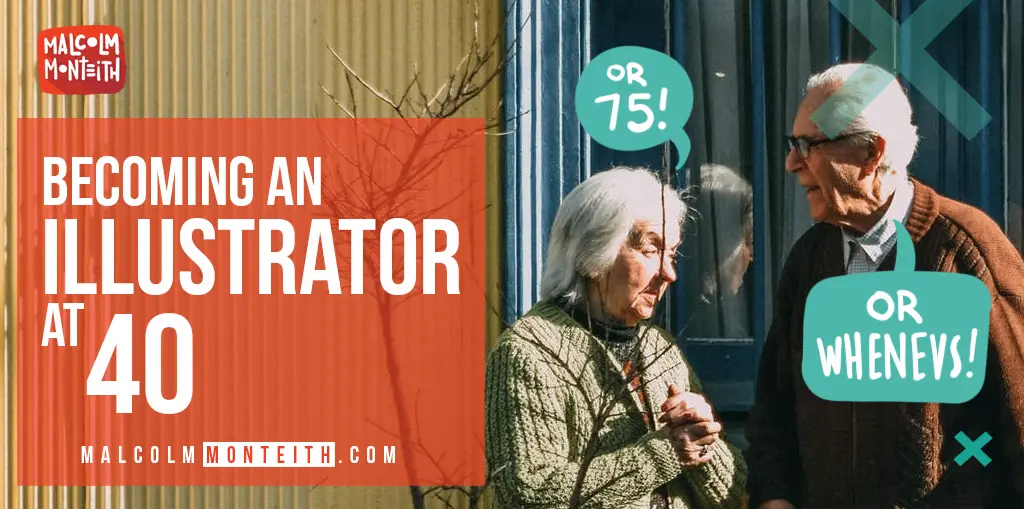First of all, I’d like to say, happy 40th to you! Okaaay maybe you’re not 40 – but let’s use this age for argument’s sake. Perhaps you are reading this because you have spent years in your current line of work and you are now looking for a change of career into the world of illustration. And maybe you are wondering if it’s possible to make this change.
Becoming an illustrator at 40 is definitely possible. To make a successful career change into the illustration industry, you will need a complete illustration portfolio, a solid plan and access to money that you have saved up.

What are the Things You Need to Consider Before You Take the Leap?
In this article, we’re going to look at how to become an illustrator late in life. We will be discussing four super duper important things you need to consider:
- Your family
- Your money
- Your illustration portfolio
- When to start
Buuut what about a qualification? Do you need to go blow a whole lotta cash on some upskilling?
Can you be an illustrator without a degree?
You do not need a degree to become an illustrator. The most important things are your illustration portfolio and your work ethic.
(By the way, once you’re done reading this article, check out my main article on how to become an illustrator for more tips on getting started!)

When can you call yourself an illustrator?
Don’t think that you need to be working as an illustrator full time in order to call yourself one. You can call yourself an illustrator any time, in any job. If you work in a completely unrelated profession, but you love drawing and you sometimes even make money from it, then you are an illustrator.
Remember that illustrating for other people is not the same as illustrating for yourself. The luxury of keeping your day job is that you will be able to pick and choose the illustration jobs that you would love to do most.
What if I Reeeeally Want to Do This Full Time?
If your surname is Kardashian or Bezos, then you can get started with your illustration career right away. Otherwise, please read on to see how you (and your family) can plan for your career change.
Your Family
First let’s talk about responsibilities.
(Now you may feel like I’m pooping your party in this section, but still, it’s very important.)
You are Part of a Team
Becoming an illustrator at 40 is not the same as becoming one at 20. Do you share your life with someone? Maybe you are married? Perhaps you have a child or ten?
If so, you are not an island – you are just one piece of a bigger family continent.
You need to recognize and accept that your family are along for this ride with you. And your family is your responsibility.
Talk About it and Get Them on Board
Make sure that you have discussed this with your significant other before you completely immerse yourself in this career change. If you’re going into this with a partner who is not supportive, then this may cause problems in your relationship.
Make sure you come to some sort of agreement – for example, if after two years you haven’t brought in x amount of money, then perhaps switch back to your previous career.
Does Money Buy Happiness?
The saying goes ‘Money does not buy happiness”, but I’ll tell you for free…
Money does solve a lot of problems.
Also, lack of money will cause problems.
Wow all this talk of money makes me want to move on to our next section!
Your Money
Have you ever done trapeze? Yeah neither have I.
But similar to trapeze artists, you need to make sure you are holding on to something before you let go of something.
If you decide to pursue this new career, you will need to have money before you try to make money as an illustrator.
This is where you may want to do a bit of maths and budgeting. How much money do you need to have saved up to allow you to not work for an entire year? This is a reasonable amount of money that you will need in your bank before making a career change to illustration.
Why?
If you’re becoming an illustrator late in life, there is a very high chance that you are going to be taking a few steps back financially.
A year’s supply of money is there as your safety net while you are working on your projects and trying to get new clients.
This financial safety net will be there to keep your mind at ease so that you can focus on getting your work done and marketing yourself to others who may want to hire you.
Your Portfolio
Before you quit your day job, you will need a bit of preparation first.
- Make sure you have a beautiful and complete portfolio that shows that you know what you’re doing
- Make sure you have a few clients lined up
If you’d like some quick tips on how to put together your illustration portfolio, check out my article here on how to get your first illustration job.
For your portfolio, you will need 10 to 12 solid pieces of art that you are proud of.
Also, you will need to know who your audience is. For example, if you are wanting to work creating scientific diagrams for textbooks, then your portfolio needs to reflect this (whereas a portfolio of cartoon critters probably won’t give your clients faith in your scientific diagram illustrating skills)
When to Start?
There are two things to consider here:
- When do you start working as an illustrator?
- When do you quit your day job?
These two dates should not be done at the same time.
Don’t Quit Your Day Job… Yet
Your day job has a purpose – to bring in money and pay the bills at home. Do not see it as something you need to escape from. Instead, consider gradually finding illustration jobs while you are still employed.
If you manage to pick up an illustration project, then set aside some time after dinner every night, or get up a bit earlier, or stay home on the weekends.
There’s plenty of time you can get back in the day if you make a few social sacrifices.
If this routine works for you, then you can keep doing this as long as you can until you have a good network of clients that keep coming back to you for your services.
Put On Your Jetpack – Time to Get Outta Here!
If you have successfully followed the above points about family, money, your portfolio and getting started while still employed, then it might be safe to go all in with your illustration career.
If you are on good terms with you employer, I recommend that you apply for a ‘career break’, where they agree to go on extended unpaid leave while you are still an employee of the company. That way, if this illustration gig doesn’t work out for you, you can always go back to where you were.
Let’s Recap!
Is it too late to become an illustrator?
It doesn’t matter if you’re 30, 40, or 60. Regardless of your age, it is never too late to become an illustrator. Anyone can learn to draw and build up a portfolio of work. You’ll be surprised at how good you can become if you put in the time and effort.
Just be mindful that before you leap into the world of illustration full time, you will need to do a significant amount of preparation while still financially comfortable in your day job.
Before You Make the Move, Remember To:
Discuss your plan with your family – they need to be on board with this and it is your responsibility to provide for them.
Save up some money so that you can live comfortably for a year.
Put together an amazing portfolio of work.
Start picking up some design contracts before quitting your day job.
I Wish You Success. I Hope You Enjoy it (and I Hope You Make Big Bucks)
Creating illustrations to help people with their businesses can be very rewarding, but any art related job can have its busy and quiet periods. Remember that if things don’t work out, you can always go back to your old line of work. Or perhaps you could even do both jobs part time.
Whatever you end up doing, I wish you all the best and hope that you are a success.


5 thoughts on “Becoming an Illustrator at 40 (How to Do it Right)”